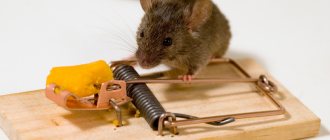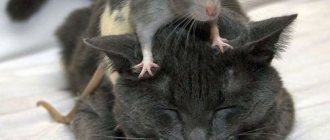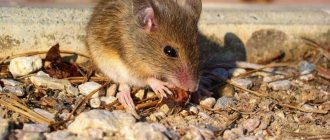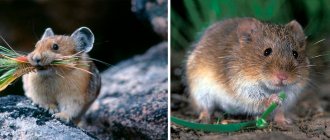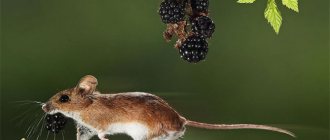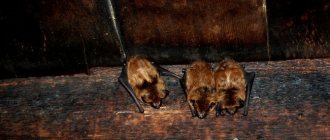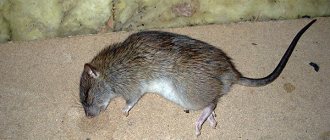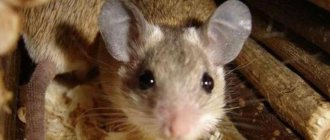At the beginning of winter, with the first frosts, mice, driven by hunger and cold, begin to invade human habitation. Mice in the house are always a huge headache for owners. They not only spread dangerous infections and announce their presence with a peculiar mouse odor, but also damage building structures, communications, and furniture. In this article we will look at:
- Why do mice try to get into the house?
- Mice in a private house: what wall material do rodents prefer?
- What to do to prevent mice from entering your home?
- How to get rid of mice in the house.
House mouse
Most mice live outdoors, but some mice prefer to live indoors. There may be enough warmth and food in your home to help mice survive the cool season. House mice are often found in Russia. These are small animals with brown-gray fur, a sharp muzzle, large ears and a long tail. House mice are relatively small, their body size is from 7 to 10 centimeters. House mouse feces can be identified by the small black grains they leave behind. House mice are most active at night.
How to get rid of mice in the house forever: metal mesh
Biologists say that a mouse will fit even into a hole that would be impossible to insert a pencil into. This is true. The mouse has a very flexible skeleton, and its skull “folds” like that of a baby during childbirth. Therefore, a galvanized mesh to protect against mice must consist of the smallest cells. The second requirement is that it must be made of very durable metal.
The mesh should be made of wire thicker than 2 mm, the cell dimensions should be no larger than 10x10 mm.
The mesh is laid on the subfloor.
They're wrapping her foundation
Or they close the ventilation holes.
All corners are covered with fine mesh (as reinforcement for plaster). It is important not to miss a single corner, not a single joint.
The ventilation gap between the insulation and the sheathing below is also covered with this mesh: you should get a box with walls at least 5 cm high.
Also, a fine-mesh mesh is buried in the ground along the perimeter of the foundation to a depth of 80 cm so that mice cannot dig under it.
To protect against mice, the base is lined with fine-mesh mesh at least a meter in height.
Professionals advise laying fine mesh wherever a mouse could theoretically sneak through.
For additional protection of the base, it is recommended to sheathe it to a height of at least a meter:
- corrugated sheet made of structural steel 1.5 mm thick (in waves lengthwise);
- slippery smooth plastic;
- plaster (but to prevent the mouse from chewing through the plaster, the top is finished with acrylic putty and slippery paint is applied to the putty).
Mouse nest, what does it look like?
Once inside, mice hide in narrow, warm places where they build nests for their offspring. The little mice are born after a gestation period of about 20-30 days. At the same time, about eight newborns appear in the brood. Before you know it, a whole mouse invasion will appear in your house. This is what a mouse nest looks like:
- The nest consists of residual waste, pieces of wire, paper, fabric and other household items found by rodents.
- The mouse gives the nest a round shape, which can be compared to a small ball, at the bottom of which the mouse settles.
- Feces, seeds and food debris are found near the nest.
Reproduction and lifespan
Reproduction of rodents Any animals can occupy a large territory only if their number quickly and constantly increases. In conditions favorable for living, house mice are able to reproduce all year round. In the wild, the main reproductive period occurs in spring (March) and ends in autumn (November). 12-18 hours after birth, the female is ready for mating.
Interesting!
In a year, one adult can bear up to 14 offspring. This amounts to a fairly large number of young offspring, because each litter can have from three to twelve cubs.
Mice are born without hair and are blind, but house mice quickly grow up:
- after 10 days they already have their own fur coat;
- by the twenty-first day they become completely independent and leave the parental nest;
- Juveniles take up to seven weeks to begin reproducing their young.
During the mating season, male house mice, trying to attract a female, emit a sound signal that fluctuates in the range of 30-110 kHz. This call, in its complexity, approaches bird singing. The female can also interbreed with another subspecies of mice, such as Kurganchik. The offspring, despite this, grow up absolutely healthy.
The life of house mice is full of dangers and risks. They often become victims of cats, foxes, snakes, mongooses, and birds of prey. Even rats are killed by these fast-moving rodents. Such a number of enemies greatly shortens their life.
On a note!
On average, a house mouse lives from 12 to 18 months, but in captivity the lifespan of a mouse can increase to 2 years.
Rodents have poor vision, but other senses help them survive: hearing and smell:
- the ability of house mice to detect sound with a frequency of up to 100 kHz often saves their lives;
- a developed sense of smell helps to find food and identify their relatives.
Diseases caused by mice
The mouse chews food and spreads urine and feces throughout the day. Transmission of the disease from mouse to human occurs by touching mouse feces, eating contaminated food, or direct contact with an infected mouse. If you suffer from mice, it is important for your own health to begin rodent control as soon as possible. You can try to control mice yourself, but we do not recommend this for the sake of your health. The most common diseases carried by mice are:
- Salmonella
- Hantavirus
- Leptospirosis
Salmonella
Salmonella is found in the intestines of mice and is passed in the feces. Food that comes into contact with feces becomes contaminated with salmonella bacteria. By eating contaminated food, we become infected with salmonella. Symptoms such as diarrhea, abdominal pain and fever are the result of a mild infection. In cases of severe infection, salmonella enters the bloodstream. Additional symptoms in these cases do not disappear on their own.
Hantavirus
Mice transmit hantavirus in urine and feces. When stool or urine dries, virus particles become airborne. Inhaling contaminated air causes hantavirus infection. Hantavirus infection causes serious health problems. The incubation period of the virus is six weeks. In the initial stage, symptoms such as fever, headache, nausea, muscle aches and fatigue develop. This virus has no cure or vaccine. Hospitalization is the only treatment for hantavirus.
Leptospirosis
Leptospirosis is a bacterium that lives in the kidneys of mice. Bacteria are excreted in the urine. The bacteria are transmitted to humans through direct or indirect contact with mouse urine. After exposure to leptospirosis, you will feel ill for two to thirty days. Most infected people develop mild symptoms, such as fever, muscle pain and headache. About ten percent of leptospirosis infections develop severe symptoms, including lung disease and liver and kidney damage.
Habitat
Habitat of mice House mice are quite mobile creatures.
They easily change their homes when cold weather sets in and move to houses, barns, cellars, warehouses and granaries, running about 3 to 5 km. If the winter is not very severe, then the animals can be found in haystacks and stacks, as well as in the forest belt. House mice living in hot climates do not migrate far, but try to stay close to a water source. Under natural conditions, they settle on soft soils, in which they dig minks at a depth of up to 20-30 cm. In the cold season, the nest can be deepened to 50-60 cm. House mice dig up to one meter in length to reach their home and make emergency exits in two or three directions.
The bottom of the mink is covered with soft twigs, paper, pieces of fabric, and bird feathers. If there are nests of other small animals nearby, then house mice can survive the owner or settle in natural cracks and holes that form in the ground.
Interesting!
These small rodents keep their home tidy and clean. If the litter suddenly gets wet, becomes very dirty, or becomes infested with parasites, house mice immediately leave the nest and build a new one.
The animals are nocturnal animals, but when living with people, they adapt to their waking schedule. In artificial light conditions they can remain active for 24 hours. When inhabiting human territory, house mice look for secluded corners under the floor, in attics in garbage waste.
If you look at photos of house mice, it may seem that they are so safe and defenseless. But under certain conditions they themselves can act as predators. Nature has rewarded them with mobility:
- run fast (12-13 km/h);
- jump and climb well;
- They can swim well.
Under natural conditions, house mice try to settle separately from each other, but if this is not possible, they settle in small families consisting of one male and several females with cubs. Within the family, aggressive behavior is rarely observed. Skirmishes occur mainly between males and during the period when the new grown generation survives from the nest.
Do-it-yourself mice control
If you notice mice in or around your home, you can try to combat the mice yourself. The most common methods are using mouse poison, setting mousetraps, installing mouse bait boxes, or trapping mice. If you don't want to control the mouse yourself, you can contact our professional pest control agents here. Have you tried any of the above methods without success? Then consult one of our professionals, we will be happy to help you!
Which doctor will help?
Many people, in case of bites from rats or other animals, turn to doctors who help diagnose and subsequently get rid of side symptoms. But the causes of diseases and their origins must be treated first.
If you were bitten by a rat or mouse or someone else, or you constantly smelled the smell of carrion at home, and after that you felt unwell, then you urgently need to run to an infectious disease doctor.
There is no need to wait for the disease to manifest itself. With some diseases, such as the bubonic plague, you cannot hesitate, because the risk of dying or being near death is extremely high. Fever, rash, elevated temperature - all this indicates that the disease has already entered the active phase and the minutes are counting.
It is recommended to see a surgeon with an infectious disease specialist to treat ruptured bite wounds or ulcers.
Nutrition
Nutrition of mice Under natural conditions, house mice feed on the seeds of various plants.
They prefer cereals, legumes, and asteraceae, but do not disdain insects and their larvae. They can feed on carrion. If there is access to water, house mice eat plants. Green matter can make up up to a third of their normal diet. House mice should drink up to 3 ml of water per day. If they are exposed to dry climates and eat only dry food, they will die from dehydration within two weeks.
Interesting!
The proximity to humans gives them a clear advantage in the variety of food. They can eat not only their usual food, but also meat, dairy products, and love chocolate. In the absence of the owners of the house, it is not difficult for them to try soap, candles, glue and other things useful to humans.
Gray rat
Enlarged relatives of mice cause troubles on an even larger scale. Rats differ from other rodents in their increased need for food of animal origin. It is not surprising that they are drawn like a magnet to human habitation: after all, our ordinary food waste represents a wonderful, balanced food for these tailed creatures. One rat destroys 7–10 kg of food per year.
Article on the topic
Nightmare with a tail
Unfortunately, tailed animals not only eat a lot, but even more “bite” everything in their path. They can render unusable not only household items, but also building structures, electrical wiring and appliances. In addition, the rat is a natural carrier of at least 20 infections dangerous to humans and several types of helminths.
